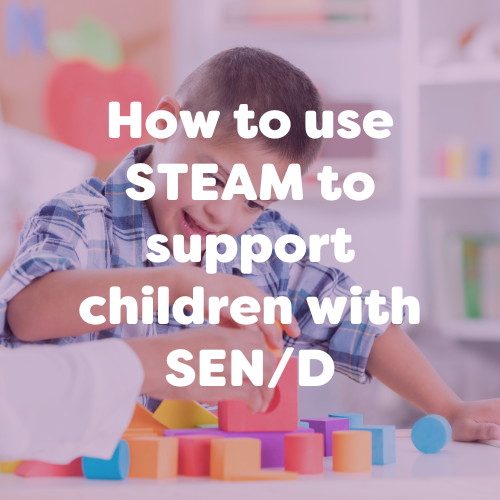STEAM refers to the educational model that incorporates science, technology, engineering, arts and maths. To learn more about the specifics of STEAM and discover some activity ideas that use this model then head to our dedicated blog post: STEAM in early years.
SEN/D refers to special education needs and or disabilities. These needs or disabilities can often affect a young person’s ability to learn in many different ways. In this blog, we will be looking at how STEAM projects can be used to help support and educate children with SEN/D and also offer a few “best practices” guidelines to use.

Why use STEAM to support children with SEN/D?
STEAM can sound like quite a complex topic so why use this with children who have difficulties or delays with learning? Read on for some of the unique benefits that STEAM learning can offer children with SEN/D.
- Often, children with SEN/D may be delayed in some areas of learning such as reading but may be exceptional in other areas like maths or art. Using STEAM, which combines 5 different areas into one complementary approach, children will be able to engage in activities that they love and can excel in. Whilst simultaneously fostering an interest in other subjects.
- STEAM activities and projects naturally feature a lot of hands-on, interactive and creative activities. This can be used to create a more inclusive and engaging learning environment. This not only supports and engages children with SEN/D but does not single them out.
- STEAM activities can also be used to support various needs or disabilities. For example, technology and assistive devices can be used to support children with language or communication difficulties to allow them to participate and express themselves. Engineering activities such as simple construction can benefit those children with motor difficulties or physical disabilities by supporting fine motor development and spatial awareness.

Best practices for introducing STEAM to children with SEN/D
So now the benefits of this approach are clearer – how do you go about introducing STEAM topics to children? Below are some “best practices” to follow that will make the process seamless and produce the most beneficial outcomes.
Start with their interests and strengths
As mentioned above, some children with SEN/D may be excellent in certain areas whether that be maths or art. Or they might just have a particular interest in these subjects. Once you have identified these topics, simply use them as a starting point. This will make the material much more engaging and relevant for the individual child.
Use visual and hands-on support
It is often the case that children with SEN/D benefit from visual aids to help them understand and retain new information. Consider graphs, hands-on manipulatives, diagrams and graphic organisers or mind maps to explain an activity.
Use a variety of teaching approaches
Consider using a scaffolding technique when teaching as breaking activities down into smaller chunks can help children with SEN/D to complete tasks.
Also, consider providing your children with options rather than a set outcome for a task or activity. Encouraging children but not being rigid with instructions can often lead to a better outcome when introducing STEAM topics. You will likely be surprised by your children’s creativity and problem-solving skills.
Be patient and positive
Remember that STEAM may be a new concept for your little ones whether they have SEN/D or not. It is important to be patient and allow extra time for children to process the new information. It is also important to simultaneously provide positive reinforcement and encouragement along the way.
Do not use abstract language or instructions
Many children with SEN/D, especially those with autism, tend to struggle with figurative or abstract language. Make an effort to give clear and concise instructions to support a better understanding of tasks and concepts.
As always, we would love to hear your thoughts. Share your experiences with us on social media by tagging us or using the hashtag #ExploreWithEYR



